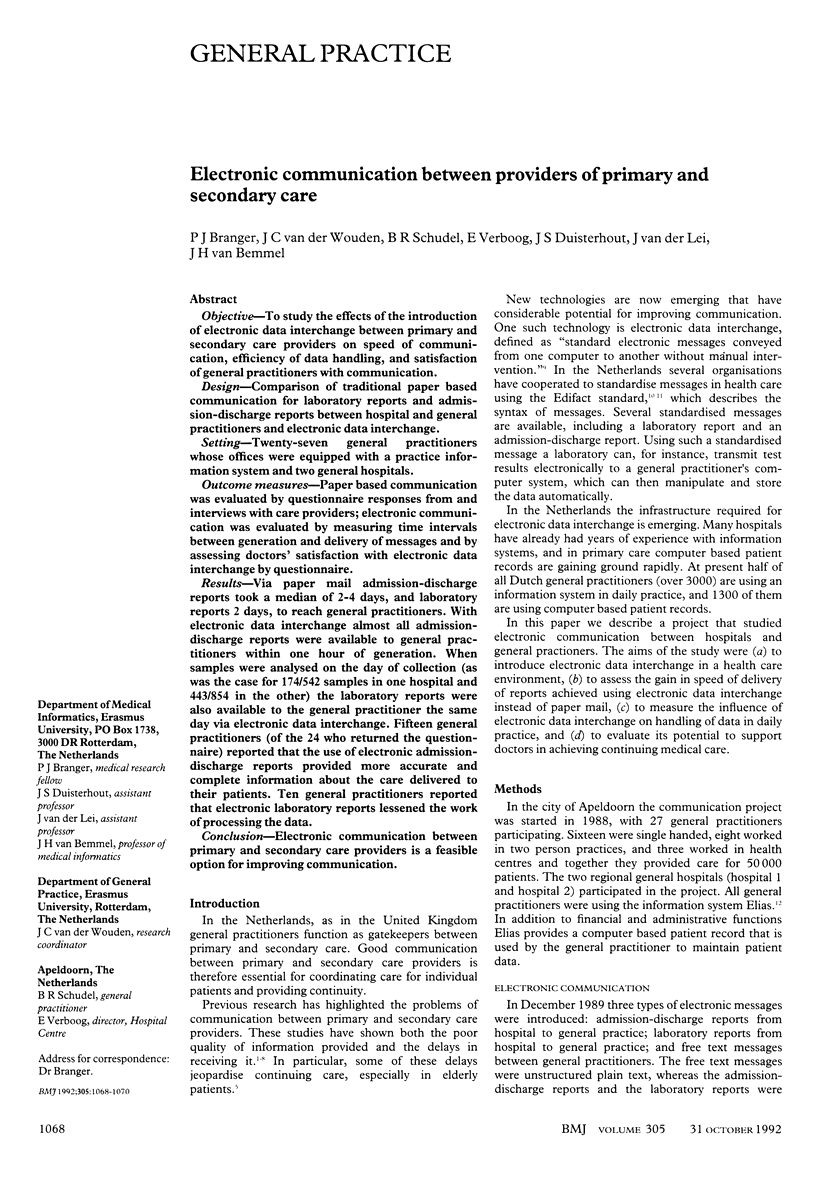Abstract
OBJECTIVE--To study the effects of the introduction of electronic data interchange between primary and secondary care providers on speed of communication, efficiency of data handling, and satisfaction of general practitioners with communication. DESIGN--Comparison of traditional paper based communication for laboratory reports and admission-discharge reports between hospital and general practitioners and electronic data interchange. SETTING--Twenty-seven general practitioners whose offices were equipped with a practice information system and two general hospitals. OUTCOME MEASURES--Paper based communication was evaluated by questionnaire responses from and interviews with care providers; electronic communication was evaluated by measuring time intervals between generation and delivery of messages and by assessing doctors' satisfaction with electronic data interchange by questionnaire. RESULTS--Via paper mail admission-discharge reports took a median of 2-4 days, and laboratory reports 2 days, to reach general practitioners. With electronic data interchange almost all admission-discharge reports were available to general practitioners within one hour of generation. When samples were analysed on the day of collection (as was the case for 174/542 samples in one hospital and 443/854 in the other) the laboratory reports were also available to the general practitioner the same day via electronic data interchange. Fifteen general practitioners (of the 24 who returned the questionnaire) reported that the use of electronic admission-discharge reports provided more accurate and complete information about the care delivered to their patients. Ten general practitioners reported that electronic laboratory reports lessened the work of processing the data. CONCLUSION--Electronic communication between primary and secondary care providers is a feasible option for improving communication.
Full text
PDF


Selected References
These references are in PubMed. This may not be the complete list of references from this article.
- Doeleman F. Improving communication between general practitioners and specialists. Fam Pract. 1987 Sep;4(3):176–182. doi: 10.1093/fampra/4.3.176. [DOI] [PubMed] [Google Scholar]
- Jacobs L. G., Pringle M. A. Referral letters and replies from orthopaedic departments: opportunities missed. BMJ. 1990 Sep 8;301(6750):470–473. doi: 10.1136/bmj.301.6750.470. [DOI] [PMC free article] [PubMed] [Google Scholar]
- Tulloch A. J., Fowler G. H., McMullan J. J., Spence J. M. Hospital discharge reports: content and design. Br Med J. 1975 Nov 22;4(5994):443–446. doi: 10.1136/bmj.4.5994.443. [DOI] [PMC free article] [PubMed] [Google Scholar]
- Westerman R. F., Hull F. M., Bezemer P. D., Gort G. A study of communication between general practitioners and specialists. Br J Gen Pract. 1990 Nov;40(340):445–449. [PMC free article] [PubMed] [Google Scholar]
- Williams E. I., Fitton F. General practitioner response to elderly patients discharged from hospital. BMJ. 1990 Jan 20;300(6718):159–161. doi: 10.1136/bmj.300.6718.159. [DOI] [PMC free article] [PubMed] [Google Scholar]


